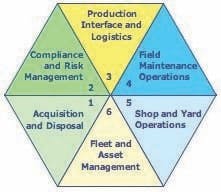The hexagon describing the six basic functions of equipment management has gained quite a following in the industry since it was introduced several years ago. It’s been used to show how management has evolved in recent years, but it can also be used to produce a world-class procedures manual that helps you structure the many day-to-day decisions needed to excel in managing a large and complex fleet.
We will go through each of the six functions briefly and then show how they can be used to address the four questions that must be asked and answered in a procedures manual.
Acquisition and Disposal. This is where it all starts. If the right machine is correctly specified, selected and acquired at a competitive price, then you are in with a chance. If the opposite is true, then it is going to be a struggle for the rest of the life of the asset. Specification and selection focus on the performance characteristics of the unit as well as the quality, reliability and customer service provided by the manufacturer and dealer. Acquisition addresses the complexities of the buy, borrow, lease or rent decision and balances these with the requirement to maintain a good balance sheet, conserve scarce capital, and hedge risk. Disposal is an art all of its own. Be assured that it will become more complex as the global market for used machines becomes ever more segmented by variations in available fuel type and complex environmental regulations.
Compliance and Risk Management. This is also a changing and growing area. The work required to ensure that the fleet is insured, licensed, inspected and in full compliance with a myriad of regulations grows daily in both volume and complexity. Handling the regulatory work load is a complex task that must be done without exception to the highest standard. If you believe it is expensive and complex to do it, know it is even more expensive and complex if it is not done.
Interface with Production and the Company. This is slightly changed from the original “Production Interface and Logistics” description. The change comes from a growing appreciation for the fact that equipment must be totally integrated into production operations and the company as a whole. Silos do not make for success. It takes time to balance the size and composition of the fleet and make sure that you have the right iron in the right place at the right time. This cannot happen unless there is an effective interface between equipment operations, production operations, and the company as a whole. It is an equipment management function to reach out, participate in, and be fully informed about company plans, goals and strategies. Remember, everyone works for the same business; understand that we are, in every sense of the word, each other’s customers.
Field Maintenance Operations. The importance of this speaks for itself. No one doubts that this is a critical equipment management function, but questions abound. Who sets the standards and expectations? Who does the work? Who ensures that there is no compromise on quality and timing? Again, there have been changes with a growing emphasis on condition-based rather than scheduled maintenance, fluid management, cleanliness and lots of technology to help us ensure that field maintenance is done right and done right on time.
Shop and Yard Operations. The demand for excellence has also grown in this part of the hexagon. Major repairs and rebuilds have become more important as machine design improves, costs go up, and economic life increases. Shop operations, whether outsourced or self-performed, lie at the heart of a process whereby machines come off one assignment; are renovated, repaired or rebuilt; and made ready for their next assignment. Yard operations continue to be critical as more small tools, tooling, false work and formwork must be cleaned, inventoried and stored for the next job. Everyone seems to need more “stuff.” Everyone seems to need a bigger and a better-managed yard.
Fleet and Asset Management. This is the part of the matrix where all the data come together: where the numbers are crunched and where actionable information is produced. Equipment management is a transaction-intensive business, and converting data into actionable information is not a trivial task. This function is responsible for strategic decisions regarding fleet composition, fleet average age, capital expenditure, finance, tax and return on investment. This is also where you analyze costs and provide the estimated hourly owning and operating cost rates needed to manage the internal cost recovery processes and produce accurate bid estimates. Making good hard-cost-based decisions is the price of admission to construction. This function makes sure that the equipment side of the house lives up to expectations.
If the six equipment management functions that make up the matrix provide a solid foundation for world-class fleet management, then it is relatively easy to see how they can be used to structure a world-class fleet management procedures manual. Gone are the days when everyone knows what everyone does; and gone are the days when we can rely on chance, tradition and good luck to accomplish everything that needs to be accomplished. There is no doubt that we need to write down our policies and procedures, test them in the school of hard knocks, modify them, keep them flexible, and use them to ensure consistent quality in the service we provide our customers.
As a very minimum, a procedures manual needs to be clear on four things:
- What we need to do to fulfill the requirements of a particular function and exceed expectations in the performance of that function.
- Who is going to do it and what resources they are going to use to achieve the desired results.
- How it is going to be done. What skills, knowledge and abilities are needed to accomplish it. What standards and expectations are.
- When it is going to be done. What the schedule and frequency of action is, and what the expectations are regarding timely performance.
One thing I do know about equipment management is that everyone does it differently. One size most definitely does not fit all. So, here is my challenge to you.
- Set up a matrix where there is one row for each of the six functions in the matrix and a column for each of the four procedures manual requirements set out above.
- Appoint a team of the two or three people most concerned with a particular function. Include the lead person in performing the function and the lead internal customer.
- Ask the team to think seriously about their row in the matrix and detail out what needs to be done, who is going to do it, how are they going to do it, and when they are going to do it.
It will not be a trivial task. But you will produce a procedures manual that covers all the functions and ensures they get done by the right people, to the right standards, at the right time.





